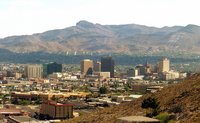Among nation's poorest cities, El Paso ranks a notorious 4th
August 27, 2008
The Sun City's poverty rate of 27.4 percent in 2007 was better than the rates for Buffalo (28.7 percent) and Detroit (33.8 percent), two former economic powerhouses. El Paso's 2007 poverty rate was only slightly improved from the 27.7 percent rate of 2006.
Written by Diana Washington Valdez, The El Paso Times

EL PASO -- El Paso is the nation's fourth-poorest city among U.S. cities with populations of 250,000 or more, according to statistics for 2007 released Tuesday by the U.S. Census Bureau.
The Sun City's poverty rate of 27.4 percent in 2007 was better than the rates for Buffalo (28.7 percent) and Detroit (33.8 percent), two former economic powerhouses. El Paso's 2007 poverty rate was only slightly improved from the 27.7 percent rate of 2006.
Among counties, El Paso had the third-highest poverty rate (28.7 percent) in 2007 for a county its size; the rate was 27.7 percent in 2006.
El Paso homemaker Christy Rios, a mother of four, said she and her husband live comfortably but still "paycheck to paycheck."
"My husband is a retired firefighter, but he commutes to Las Cruces to another firefighter job to supplement our income," she said. "The census statistics are surprising. I know our proximity to the border and our wages and issues with health care are factors. We continue to be this little stepsister of Texas, which you think of as a prosperous state."
"The city is growing, but the income is not," said Carlos Aguilar, an economic analyst and professor at El Paso Community College. "On a positive note, the new four-year medical school will open eyes to the need for higher education attainment rates.
"It may be a worn-out saying, but it's also one that's true. Our income situation will not improve until we have more people with a higher education. For those who have degrees and can't find well-paying jobs, I recommend they wait a while, or move to a place that offers what they need."
To measure poverty, the census used the federal government's income threshold of $21,203 for a family of four.
The census also reported that El Paso's median household income was $34,980 in 2007, which means half the families made more and the other half made less than that. The median income for Texas was $48,376.
Another column of the census figures indicated the rate of children living in poverty nationwide was 19 percent, the highest of the age groups compared. Poverty levels also were higher for Hispanics and the foreign-born than for other groups.
Nationally, the census reported 37.3 million people were living in poverty in 2007, including 13.3 million children.
Bill Bentley, president and CEO of the Washington-based Voices for America's Children, was in Kansas City when the Census Bureau released the figures.
In a telephone interview, he said the new presidential administration and Congress will need to invest more in programs that improve the lives of children and their families.
"We have to do a better job of mobilizing the public, and start demanding that Congress make kids a priority, and not just give the issue rhetoric," Bentley said. "It's incredible a country as affluent as ours has accepted the idea that it's alright to have a permanent underclass and for a subset of that population to be children."
Voices for America's Children advocates for children's needs and has members in Texas.
Highlights from the Census Bureau's latest reports on poverty and the United States:
The poverty rate for Texas for a three-year average (2005-2007) was 16.4 percent; the national poverty rate for 2007 was 12.5 percent.
The 28.7 percent poverty rate for El Paso County was the third-highest in the nation for counties with populations of 250,000 or more.
The 2007 median household income for El Paso was $34,980; for Texas it was $48,376.
Women working full-time, year-round averaged 78 percent of what men earned; this 2007 gender wage gap existed in practically all professions.
See more at www.census.gov.
![]()
![]()
Related Stories
![]()
Fair Use Notice
This site contains copyrighted material the use of which has not always been specifically authorized by the copyright owner. We are making such material available in our efforts to advance understanding of environmental, political, human rights, economic, democracy, scientific, and social justice issues, etc. We believe this constitutes a "fair use" of any such copyrighted material as provided for in section 107 of the US Copyright Law. In accordance with Title 17 U.S.C. Section 107, the material on this site is distributed without profit to those who have expressed a prior interest in receiving the included information for research and educational purposes. For more information go to: http://www.law.cornell.edu/uscode/17/107.shtml. If you wish to use copyrighted material from this site for purposes of your own that go beyond "fair use", you must obtain permission from the copyright owner.